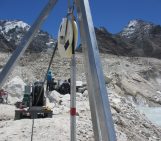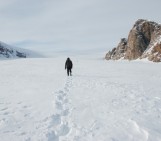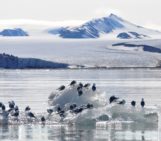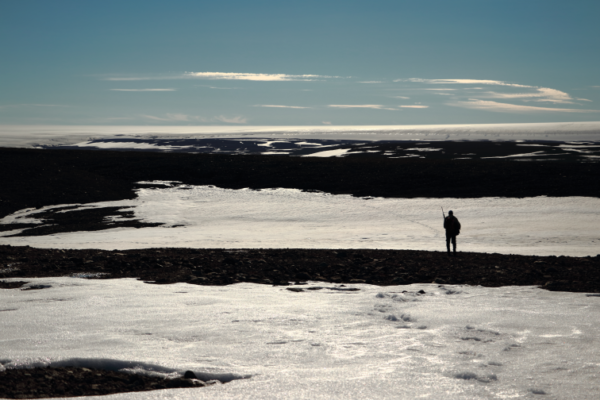
We are getting used to perceiving glaciers more and more distant and disconnected from our mountains. With each passing year, it is more difficult to observe them, reach them or climb them. They are becoming an exotic element of the Alpine imagination. When our gaze rests on a mountain glacier, with its crevasses and large moraines, we are filled with the fascination of someone observing a new natural wonder.
Facing an Arctic ice cap
In the Arctic, it is not like in the Alps which I know quite well. Up there, glaciers are not part of the landscape, they can actually be the landscape.
When we arrived, I knew that the glacier we were going to reach was about 20 km away from our base. As soon as the sky became clear, I looked into the distance, searching for the shapes and features of the glaciers I have come to know in the Alps. I could see nothing. On the contrary, an annoying blanket of moisture clung to the horizon. The whitish band never moved.
Talking to the other people at the base, I revealed to them how disappointed I was that I was on Greenland but could not observe Greenland’s second largest glacier, the Flade Isblink ice cap, even though it was only a few kilometers from where we were. They looked at me strangely, ‘What do you mean, you can’t see the glacier? It’s there! The white band is the ice cap!”
My astonishment was great, the blanket of clouds was actually the glacier. It filled the horizon and was so extensive that it could not be comprehended in one look. Once I solved the mystery, due to my naïve attempt to read the Arctic landscape through Alpine canons, the cap began to haunt me. Everywhere I went, I felt its gaze fixed on me, even in the midnight sun. The solemn monotony of the immense glacier and the silence into which it had sunk seemed inhuman.
Observing the glacier one last time as we gained altitude in the plane, I realized that the alien was me: the human observer. The ice cap was just trying to help me understand.
Edited by Loeka Jongejans
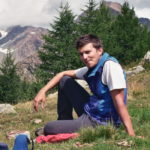 Giovanni Baccolo is a postdoc at the Paul Scherrer Institut in Switzerland. He studies glaciers to unveil the environmental and climatic pieces of information trapped within ice and snow. His research is mostly focused on ice geochemistry which he uses to study ice cores and supra-glacial processes. He tweets as @g_baccolo. Contact Email: giovanni.baccolo at psi dot ch.
Giovanni Baccolo is a postdoc at the Paul Scherrer Institut in Switzerland. He studies glaciers to unveil the environmental and climatic pieces of information trapped within ice and snow. His research is mostly focused on ice geochemistry which he uses to study ice cores and supra-glacial processes. He tweets as @g_baccolo. Contact Email: giovanni.baccolo at psi dot ch.


